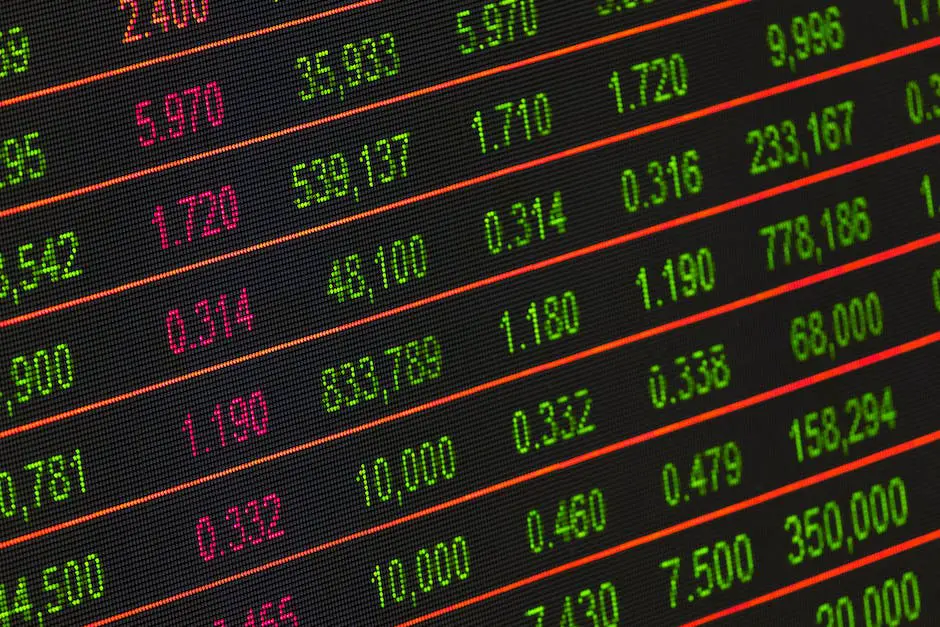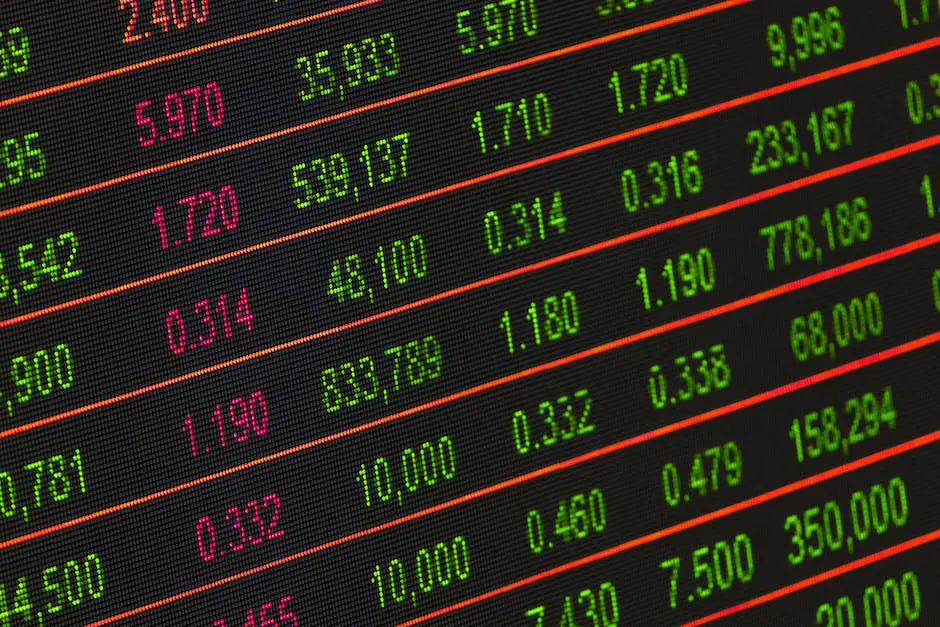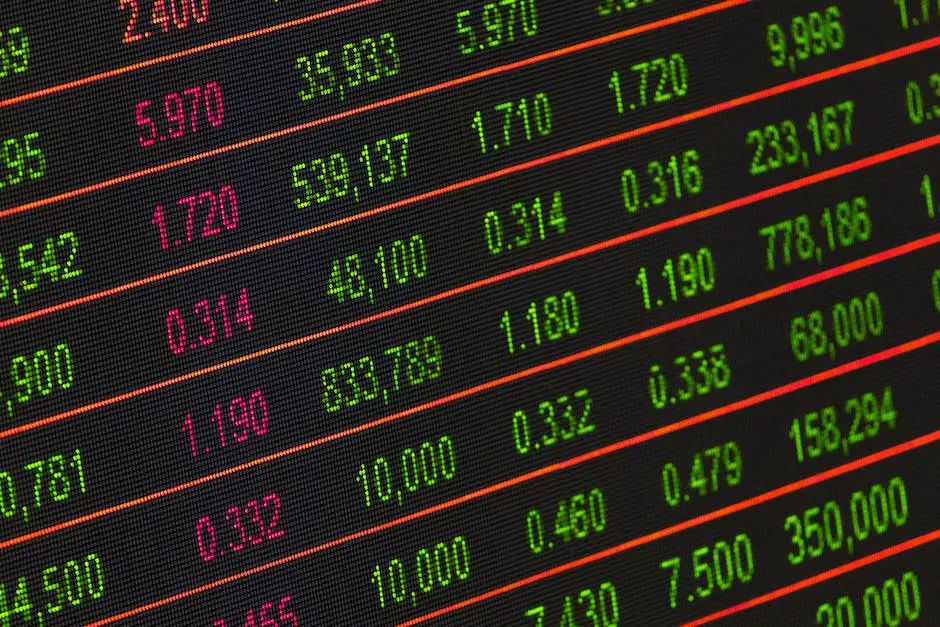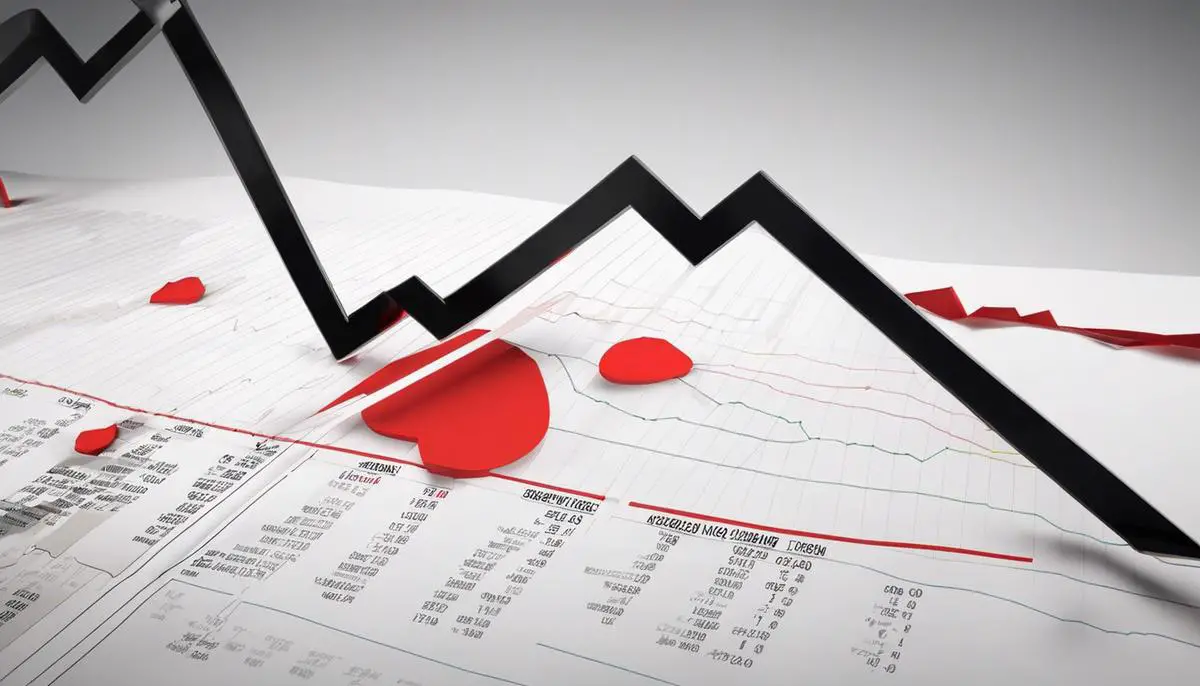In the ever-escalating world of finance, understanding the potential for upheavals and their implications is vital, whether one is a casual observer or an engaged participant. Our journey begins by scrutinizing market crash indicators and triggers, segueing into the direct impact on businesses large and small. We then delve into the effects on individual investors, exploring the potential emotional shockwaves and the actual erosion of investment value. Unravelling the web of international economic links, we reveal why a U.S. market crash is not an isolated event, but rather a disturbance that reverberates across the global economy. We conclude with practical and innovative tools for thriving amid potential chaos, navigating market turbulence, and transforming it into opportunities.
Market crash indicators and triggers
Unveiling the Tell-Tale Signs: Key Signals and Triggers Leading to a Market Crash
Market crashes. These two words send a shiver down the spines of investors, brokers, and nearly anyone with a vested interest in the world of finance. The capacity to predict these events is an ability much desired but rarely achieved. However, there are key signals and triggers that can provide insight into these unfortunate circumstances. Whether one is a seasoned veteran of the financial world or a beginner, understanding these indicators can be advantageous in altering investment strategy.
Firstly, understanding the behavior of credit markets is paramount. When the cost of borrowing becomes excessively high prompting what is known as a credit crunch, it’s a clear red flag that things are about to take a downturn. Financial institutions will tighten lending conditions or pull back on lending altogether. This restricts the flow of money, impacting a plethora of categories, ranging from investments to product creation and innovative pursuits.
Secondly, being well-informed about changes in policy direction by the Federal Reserve plays a crucial role. Tabs need to be kept on interest-rate changes, quantitative easing (QE), and other policies. These monetary alterations often prelude to turbulence in the financial market. Historically, bear market periods have often been accompanied or initiated by an increase in the federal funds rate.
Next, observing asset-price levels is also vital. History has shown that when assets, be it housing or stocks, are overpriced, a correction is bound to happen. This becomes imminent when these prices vastly outpace the fundamental earnings capacity of the economy. When the metrics, like the price-to-earnings ratio, get to low double-digits, one should not be surprised when an economic bubble gives way to a market crash.
Furthermore, significant economic indicators, such as the yield curve, need to be considered. Normally, long-term debt instruments have a higher yield than short-term ones. However, when there is a yield-curve inversion, wherein the scenario is reversed, this can signal an impending recession – a phenomenon which occurred before the 2008 global financial crisis.
Lasty, booming sectors driven by speculative heat and frothy expansions often lead to market crashes. Whether it’s the housing bubble in 2008, or the dot-com bubble burst at the turn of the century, irrational exuberance in any part of the market is a disaster waiting to happen. Keeping informed about the levels of speculation and maintaining a level head can guard against the fallout of such market collapses.
Whether one views the market crash as a calculated risk or an inevitable spanner in the economic machinery, the importance of keeping abreast of these triggers can never be overstated. With this understanding, one can courageously hold the reins to their finances, remaining unswayed by the ebb and flow of market dynamics. A well-informed approach not only helps mitigate potential losses but also aids in sighting opportunities in the chaos.

Effect on businesses
When the stock market tumbles, the financial waves extend far beyond Wall Street and impact businesses across the spectrum, regardless of size. Navigating these tumultuous waters can be particularly challenging for both grand multinational conglomerates and mom-and-pop shops alike; however, it presents opportunities for persistent entrepreneurs. Let’s take a deep dive into how a stock market crash directly impacts businesses.
Market crashes are a wealth destroyer. A catastrophic collapse can wipe out billions of dollars in wealth, affecting consumers’ purchasing power. The result is lowered demand for goods and services across various industries. From automakers to shoe manufacturers, every business becomes vulnerable when people cinch their belts tighter. More significantly, a downturned market can create a ripple effect on the overall economy, eventually morphing into a recession. Business revenues take a hard hit during such periods which, in turn, affect their survival and growth.
In a bear market, the ability of companies to secure financing becomes stringent. Generally, businesses rely heavily on external financing to manage operations, develop new products, launch marketing campaigns or even pay wages. However, market crashes often lead to credit crunches, making it difficult for businesses to access loans and credits. Furthermore, it can lead to heightened lending standards and elevated interest rates. Startups and small businesses which don’t have enough cushioning suffer the most due to their limited access to capital and dependency on external debts.
Stock market crashes can lead to a vicious cycle of layoffs and unemployment. As revenues shrink and credit lines dry up, firms may need to reduce costs. Unfortunately, one of the quickest ways to do this involves trimming the workforce. This can trigger a ripple effect throughout the economy—increasing unemployment rates, decreasing consumer confidence and spending, thereby, spiraling into slow economic growth or even recession.
However, even in the gloomiest of times, entrepreneurs find opportunities. Firstly, any crisis leads to a correction in market values. Thus, businesses in a position to invest might find lowered share prices a lucrative investing opportunity, enabling them to establish firm ownership at a minimal cost.
Secondly, a recession can stimulate innovation. Businesses are forced to evaluate their operational efficiencies, rethink strategies, and adapt to new market realities. You notice surgence in new products or ingenious services that are more recession-resistant.
Lastly, market crashes often result in increased merger and acquisition activity. Weaker companies, which were previously inaccessible, may suddenly become ripe for acquisition, enabling an increase in market share for companies who see the long-term growth potential.
As evident, a stock market crash doesn’t spell doom for every business equally. Yes, the initial shockwave will be overwhelming, but like any crisis, the ability to pivot, innovate, and adapt will determine who sinks and who floats. The key is not just to survive but thrive by turning challenges into opportunities. As wisely put by Winston Churchill – “Never let a good crisis go to waste.”

Consequences on individual investors
Let’s shift gears and delve into the perspective of individual investors when the stock market takes a nose-dive. When the roller coaster that is Wall Street takes a steep dive downwards, it isn’t just large corporations that feel the heat, every investor in the game feels the burn.
Imagine you’re the classic investor – you’ve got a good mix of stocks, bonds, and mutual funds in your portfolio. Unfortunately, when the market crashes, it’s your stocks that bear the brunt. A sinking market means lower stock prices, lower company earnings, and inevitably, lower returns on your investments. Small investors who lack the resources of big players can often feel cornered as share prices plummet, slashing their portfolio’s worth.
But what about those bonds? Unfortunately, the flip side isn’t any rosier. During a crash, yield rates often drop as investors scramble for safer bets like government bonds. This high demand pushes up bond prices but means lower yields for new investors. So even the traditionally ‘safe’ part of your portfolio is impacted.
Let’s not forget those mutual funds. Often hailed as the ‘little man’s entry into the market,’ these too suffer when stocks dive. After all, most mutual funds consist of a basket of stocks. When those stock prices fall, the net asset value of the mutual fund units drops, bringing down the overall portfolio assessment.
However, don’t mistake this as a time for panic. Crashes are opportunities, waiting to be leveraged. As any seasoned investor will tell you, market volatility provides a chance to buy quality stocks at reduced prices. A crash can be viewed as a clearance sale, a time to cherry-pick assets that can fuel long-term portfolio growth.
Investors must remember that while a crash brings an initial phase of volatility, markets historically recover over time. During this period, adopting a disciplined investment strategy, coupled with a diversified portfolio, could mitigate risks. Additionally, staying informed and financially literate can help navigate through the churning tide of a market crash.
Similarly, in the face of a downturn, restructuring and reallocating assets can provide some much-needed portfolio stability. An investor’s ability to pivot during these challenging times plays a crucial role in minimizing losses and even paving the path to potential gains.
Financial resilience and adaptability are vital lessons to learn from such tumultuous events. While the immediate impact of a stock market crash can be harsh and devastating, the long-term view remains promising for those investors who dare to ride the wave, displaying patience and shrewd investment strategies.
In conclusion, while a market crash does pose immediate challenges, it simultaneously offers potential opportunities for the resilient and savvy investor. To weather such storms, investors need to understand these dynamics, make informed decisions, and ideally, seek professional advice. This way, they can navigate through the choppy waters, potentially turning an economic downturn into a strategic advantage.

The ripple effects on the global economy
Shifting our attention to the global perspective, a U.S. stock market crash does not operate in isolation. It has potent implications for economies worldwide, creating a ripple effect of profound consequences that are felt from Beijing to Berlin. Communities on a global scale find themselves drawn into the vortex of financial turmoil, triggered by a crash in one of the world’s most significant economies.
In the modern world, international economies are interconnected and interdependent like never before. As the U.S. stock market crashes, the shockwaves reach far beyond our borders.
Firstly, let’s examine how international trade sees major disruptions. U.S. companies, faced with reduced buying power and lower consumer confidence at home, begin to cut back on their imports. This reduction in orders for goods and services impacts manufacturers and suppliers in various countries. Whether it’s South Korea shipping tech components, Germany exporting cars, or China sending over textiles, these countries, reliant on export to the U.S, suffer a significant blow to their economies, leading to layoffs and the devaluation of their currencies.
Currency instability is another direct result of a U.S. market crash. Trade imbalances and investor apprehension precipitate a surge in the dollar’s demand, leading to significant fluctuations in global exchange rates. Emerging markets find their currencies plummeting, leading to inflating import costs and exacerbating economic woes.
A stock market crash in the U.S. also disrupts global capital flows. Many countries depend on the U.S. for Foreign Direct Investment (FDI). In times of financial uncertainty, U.S. investors tend to relocate their assets domestically. This reallocation deprives foreign markets of much-needed capital for projects, leaving them cash-strapped and slowing down their economic growth.
Pension funds operate on a global scale, and a U.S. market crash wreaks havoc on pension assets. Millions of foreign retirees who depend on U.S. equities as part of their investment portfolio face financial insecurity as their retirement assets dwindle.
Entrepreneurs and innovation don’t remain untouched either. They thrive on the availability of venture capital, a large portion of which is sourced from U.S. investors. A stock market crash leads to a tightening of venture capital, stifling innovation and entrepreneurial growth worldwide.
In conclusion, a U.S. stock market crash triggers a domino effect that topples economies around the world. Inspiring an entrepreneurial spirit of resilience, people worldwide must navigate these financial storms. The crisis brings about opportunities to innovate, adapt, and grow stronger, fostering a world that learns to thrive amid adversity. It calls for a collective shift in global business strategy, emphasizing the importance of financial literacy, diversification, and continuous learning to weather uncertainty successfully.

Strategies to weather the storm
The impact of a stock market crash goes beyond financial borders. It can disrupt international trade, affecting the global manufacturing sphere as suppliers in various countries suffer from halted productions and decrease in demand. Currency instability and fluctuations in global exchange rates can also weaken businesses that heavily rely on import and export transactions.
A falling stock market can also disrupt global capital flows and Foreign Direct Investment (FDI). Companies who rely on foreign investments would probably face significant funding challenges, which could result in setbacks on growth and expansion plans.
Balancing the impact on the personal scale, an often-overlooked aspect of a stock market crash is the effect on pension assets for foreign retirees. With less value in their investments, retirees have fewer funds for consumption. This can ripple out to affect sectors like retail, tourism, and hospitality which derive substantial revenues from this demographic.
Quite crucially, a negative-oriented market sentiment can lead to the tightening of venture capital, posing a tremendous challenge for entrepreneurship and innovation. Startups, which typically lack the financial cushion to weather a prolonged downturn, may find it especially challenging to survive in the post-crash environment.
However, as every seasoned entrepreneur knows, within every crisis lies potential opportunity. A shift in market dynamics can spot opportunities for growth and adaptation. Companies that manage to weather a stock market crash often emerge stronger, more efficient, and more competitive.
To navigate such a scenario, one needs to employ financial literacy, diversification, and continuous learning. Staying informed is paramount, especially when market sentiment turns bearish. Diversification acts as a safety net, spreading risk across various types of investments and reducing the potential severity of losses. Lastly, adopting the mindset of continual learning positions one to spot opportunities that others might overlook.
Without a doubt, resilient strategies go a long way in surviving a stock market crash. Remember, every market downturn, no matter how severe, is ultimately a temporary event. The ability to navigate these critical periods can spell the difference between financial survival and disaster – and maybe, just maybe, when the dust settles, one might even find that these periods of crisis have paved the way to potentially lucrative opportunities.

With the information provided, we now perceive not only the warning signs of a potentially devastating stock market crash but also its pervasive impacts on businesses, individual investors, and the global economy. Moreover, we have outlined strategies to guard against these potential pitfalls, turning what could be a financial disaster into a manageable, and even profitable, challenge. As such, navigating the complex world of stock market crashes becomes less intimidating, equipping us with the knowledge to preserve and grow capital even in the wake of financial turmoil. In the grand scheme of things, forewarned is forearmed, and with this knowledge, we are better equipped to face whatever financial storms may lie ahead.

